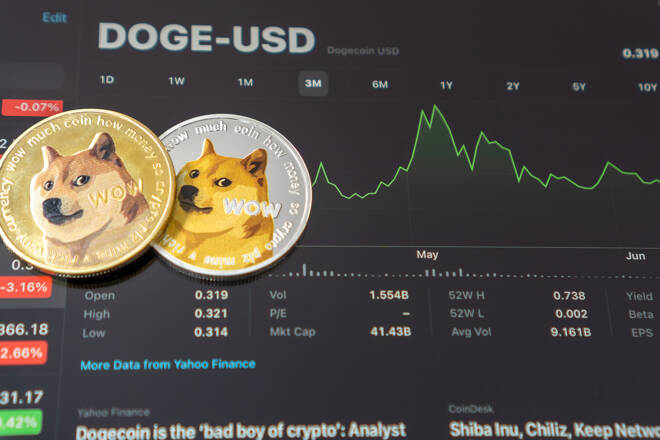Advertisement
Advertisement
DOGE and SHIB Under the Influence of the Jackson Hole Symposium
By:
DOGE and SHIB find early support after Wednesday's pullback. Expect a choppy day ahead as investors focus on US stats and Jackson Hole, Wyoming.
In this article:
Key Insights:
- Dogecoin (DOGE) and Shiba Inu Coin (SHIB) succumbed to market forces on Wednesday, with a late reversal leaving the pair in the red.
- Fed Fear led to a late pullback that surfaced due to better-than-expected economic indicators from the US.
- Technical indicators continue to turn bearish, suggesting a downward price trend for DOGE and SHIB.
On Wednesday, Dogecoin (DOGE) fell by 1.38%. Reversing a 0.62% gain from Tuesday, DOGE ended the day at $0.06789. Shiba Inu Coin (SHIB) joined DOGE in the red, falling by 1.95% to end the day at $0.00001306. On Tuesday, SHIB rose by 1.22%.
A bearish start to the day saw DOGE fall to an early morning low of $0.06702 before striking a high of $0.06966. The First Major Resistance Level (R1) at $0.0697 capped the upside.
SHIB rose to a high of $0.00001356 before sliding to a day low of $0.00001297. The First Major Resistance Level (R1) at $0.0000135 capped the upside.
Crypto news updates took a backseat on Wednesday, with US economic indicators and sentiment towards the Fed the key drivers.
US Economic Indicators Deliver Support amidst Lingering Fed Fear
Following the disappointment of Tuesday’s private sector PMIs, US economic indicators were more upbeat on Wednesday.
US core durable goods orders eased investor fears of a US recession, though failed to ease fears of a 75-basis point rate hike.
Core Durable Goods Orders increased by 0.3% in July, following a downwardly revised 0.3% rise in June. Economists forecast a 0.2% increase.
Investor angst, stemming from Fed uncertainty ahead of Fed Chair Powell’s speech from Jackson Hole, left the pair in the red.
Shiba Inu Coin (SHIB) Price Action
At the time of writing, SHIB was up 0.54% to $0.00001313.
Technical Indicators
SHIB needs to move through the $0.0000132 pivot to target the First Major Resistance Level (R1) at $0.0000134 and the Wednesday high of $0.00001356.
SHIB would need a material shift in risk appetite to support a return to $0.0000134.
In the case of a broad-based crypto rally, SHIB should test the Second Major Resistance Level (R2) at $0.0000138 and resistance at $0.0000140. The Third Major Resistance Level (R3) sits at $0.0000144.
Failure to move through the pivot would bring the First Major Support Level (S1) at $0.0000128 into play. Barring another extended sell-off throughout the day, SHIB should avoid sub-$0.0000125. The Second Major Support Level (S2) at $0.0000126 should limit the downside.
The Third Major Support Level (S3) sits at $0.0000120.
The EMAs send a bearish signal, with SHIB sitting below the 100-day EMA, currently at $0.00001337. This morning, the 50-day EMA closed in on the 100-day EMA, with the 100-day EMA narrowing to the 200-day EMA, both bearish signals.
A SHIB move through the 100-day EMA ($0.00001337) would support a run at the 50-day EMA ($0.00001346) and R1 ($0.0000135). However, a bearish cross of the 50-day EMA through the 100-day EMA would bring the 200-day EMA ($0.00001285) and S1 ($0.0000128) into view.
Dogecoin (DOGE) Price Action
At the time of writing, DOGE was up 0.77% to $0.06842.
Technical Indicators
DOGE needs to avoid the $0.0682 pivot to test the First Major Resistance Level (R1) at $0.0694 and the Wednesday high of $0.06966.
DOGE would need a pickup in market risk appetite to support a return to $0.069.
In an extended crypto rally, DOGE should test the Second Major Resistance Level (R2) at $0.0708. The Third Major Resistance Level (R3) sits at $0.0735.
A fall through the pivot would bring the First Major Support Level (S1) at $0.0667 into play. Barring an extended sell-off, the Second Major Support Level (S2) at $0.0656 should limit the downside.
The Third Major Support Level (S3) sits at $0.0629.
The EMAs sent a bearish signal, with DOGE below the 50-day EMA, currently at $0.07057. Following Wednesday’s bearish cross, the 50-day EMA eased back from the 200-day EMA, with the 100-day EMA narrowing to the 200-day EMA, both bearish signals.
A move through R1 ($0.0694) would bring the 50-day EMA ($0.07057), R2 ($0.0708), and the 200-day EMA ($0.07086) into play.
However, a pullback from the 50-day EMA would bring the Major Support Levels into view.
About the Author
Bob Masonauthor
With over 20 years of experience in the finance industry, Bob has been managing regional teams across Europe and Asia and focusing on analytics across both corporate and financial institutions. Currently he is covering developments relating to the financial markets, including currencies, commodities, alternative asset classes, and global equities.
Latest news and analysis
Advertisement
